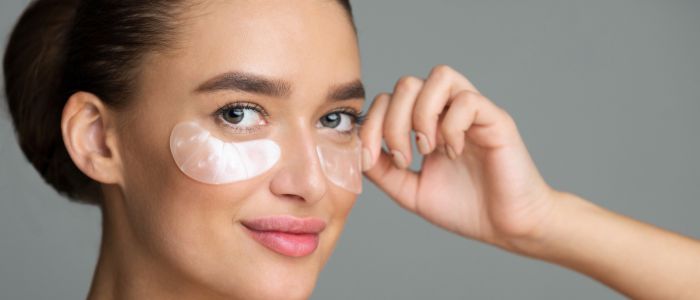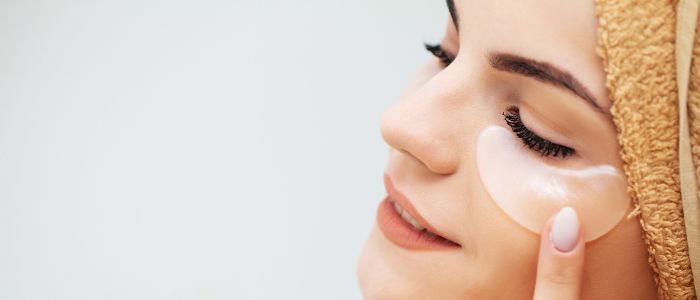
Table of Contents
- Eye Bags – Causes and Concerns
- Non-Surgical Remedies for Eye Bags
- The Role of Skincare in Managing Eye Bags
- Lifestyle Adjustments to Reduce Eye Bags
- Blepharoplasty – Surgical Solution for Eye Bags
- What to Expect from Eyelid Surgery
- Choosing the Right Surgeon for Blepharoplasty
- Preparing for Eyelid Surgery: Tips and Advice
- Alternatives to Eyelid Surgery
- FAQs about Eye Bags and Blepharoplasty
- Further Reading about Eyelid Surgery at Cheshire Cosmetic Surgery
Eye Bags – Causes and Concerns
Puffy, swollen, or discoloured under-eye areas, commonly referred to as eye bags, can be a source of concern for many people. These unsightly blemishes can make you appear tired, older, and less vibrant, even when you’re well-rested.
Eye bags can develop due to a variety of factors, including:
- Ageing: As we grow older, the delicate skin around our eyes becomes thinner and loses elasticity, making it more susceptible to sagging and the formation of eye bags.
- Heredity: Some people are genetically predisposed to developing eye bags, which may be more pronounced in certain families or ethnic groups.
- Fluid Retention: Excessive fluid accumulation around the eyes can contribute to puffiness and swelling, particularly in the morning or after consuming salty foods.
- Lack of Sleep: Inadequate sleep can lead to fluid buildup and dark circles under the eyes, exacerbating the appearance of eye bags.
- Allergies: Allergic reactions can cause inflammation and fluid retention around the eye area, resulting in puffiness and discoloration.
While eye bags are generally harmless from a medical standpoint, they can significantly impact your self-confidence and overall appearance. Fortunately, various treatment options are available to address this concern, ranging from non-surgical remedies to surgical interventions. In this blog, Consultant Plastic Surgeon Anca Breahna will discuss different methods to make the eye bags go away.
Non-Surgical Remedies for Eye Bags
Before considering more invasive treatments, it’s advisable to explore non-surgical remedies for managing eye bags. These approaches can be effective in reducing puffiness and discoloration, and may be suitable for milder cases or as a complementary measure to other treatments.
- Cold Compresses: Applying cold compresses or chilled cucumber slices to the eye area can help constrict blood vessels and reduce swelling and inflammation.
- Topical Creams and Serums: Over-the-counter or prescription-strength eye creams and serums containing ingredients like caffeine, vitamin K, and retinol can help improve circulation, reduce discoloration, and tighten the skin around the eyes.
- Facial Massage: Gentle massage techniques, such as lymphatic drainage massage, can promote fluid drainage and improve circulation, potentially reducing the appearance of eye bags.
- Tea Bags: Placing cooled, used tea bags on the eye area can help constrict blood vessels and reduce puffiness, thanks to the natural tannins and antioxidants present in tea leaves.
While non-surgical remedies can provide temporary relief, their effectiveness may be limited, and more substantial treatments may be necessary for long-lasting results.
The Role of Skincare in Managing Eye Bags
Incorporating a skincare routine can play a role in managing eye bags and maintaining a youthful, refreshed appearance. The delicate skin around the eyes is particularly susceptible to environmental stressors, dehydration, and premature ageing, making it essential to adopt a targeted approach to eye care.
- Cleansing: Gently cleansing the eye area with a mild, fragrance-free cleanser can remove impurities, makeup residue, and excess oils that can contribute to puffiness and discoloration.
- Exfoliation: Regular, gentle exfoliation can slough off dead skin cells and promote cell turnover, revealing brighter, smoother skin around the eyes.
- Hydration: Keeping the eye area well-hydrated is crucial for maintaining skin elasticity and preventing the formation of fine lines and wrinkles, which can exacerbate the appearance of eye bags.
- Sun Protection: Applying a broad-spectrum sunscreen with an SPF of 30 or higher can protect the delicate eye area from harmful UV rays, which can accelerate skin ageing and contribute to the development of eye bags.
- Targeted Eye Treatments: Incorporating eye creams, serums, or masks specifically formulated for the eye area can provide targeted benefits, such as reducing puffiness, brightening dark circles, and improving skin firmness.
By incorporating a consistent and tailored skincare routine, you can help minimise the appearance of eye bags and maintain a more youthful, radiant complexion.
Lifestyle Adjustments to Reduce Eye Bags
In addition to topical treatments and skincare routines, making certain lifestyle adjustments can significantly contribute to reducing the appearance of eye bags and promoting overall skin health.
- Adequate Sleep: Prioritising a consistent sleep schedule and aiming for 7-9 hours of quality sleep per night can help prevent fluid accumulation and dark circles under the eyes.
- Hydration: Drinking an adequate amount of water throughout the day can help flush out toxins and prevent fluid retention, which can contribute to puffiness and swelling around the eyes.
- Salt Intake: Limiting your sodium intake can help reduce fluid retention and minimise the appearance of eye bags, particularly in individuals who are sensitive to salt.
- Stress Management: Chronic stress can exacerbate inflammation and contribute to the formation of eye bags. Incorporating stress-reducing activities, such as meditation, yoga, or deep breathing exercises, can help alleviate this issue.
- Elevating the Head: Sleeping with your head slightly elevated can promote better drainage and prevent fluid accumulation around the eyes, reducing the likelihood of waking up with puffy eyes.
Blepharoplasty – Surgical Solution for Eye Bags
For people seeking more comprehensive and long-lasting results, blepharoplasty, also known as eyelid surgery or an eye lift, may be an appropriate solution. This surgical procedure involves removing excess skin, fat, and muscle from the upper and lower eyelids, effectively addressing eye bags and restoring a more youthful, refreshed appearance.
Blepharoplasty can be performed on the upper eyelids, lower eyelids, or both, depending on your specific concerns and goals. The procedure aims to:
- Remove Excess Skin: As we age, the skin around our eyes can become loose and saggy, contributing to a tired or aged appearance. Blepharoplasty can tighten and smooth the skin, creating a more youthful and refreshed look.
- Eliminate Fatty Deposits: Fatty deposits that accumulate under the eyes can lead to the formation of eye bags, making you appear older and more fatigued. During blepharoplasty, these excess fat pockets can be carefully removed or repositioned for a smoother, more contoured appearance.
- Improve Vision: In some cases, drooping upper eyelids can impair peripheral vision, and blepharoplasty can help restore an unobstructed field of vision by removing excess skin and fat.
It’s important to note that blepharoplasty is a surgical procedure and should be performed by a qualified, experienced plastic surgeon. Proper patient selection, realistic expectations, and adherence to post-operative instructions are all important for achieving optimal results and minimising potential risks.
What to Expect from Eyelid Surgery
If you’re considering blepharoplasty, it’s essential to have a clear understanding of what the procedure entails and what you can expect before, during, and after the surgery.
- Consultation: Your initial consultation with Anca is important. During this appointment, she will evaluate your medical history, discuss your goals and expectations, and determine if you’re a suitable candidate for the procedure.
- Pre-operative Instructions: Anca will provide you with specific pre-operative instructions, which may include avoiding certain medications, quitting smoking, and arranging for transportation and assistance after the surgery.
- Anaesthesia: Blepharoplasty is usually performed under local anaesthesia with sedation or general anaesthesia, depending on the extent of the procedure and your surgeon’s preference.
- Surgical Technique: The surgical technique used during blepharoplasty can vary depending on your individual needs and Anca’s approach. However, the procedure generally involves making incisions along the natural creases of the eyelids, removing or repositioning excess fat, tightening muscles, and trimming away excess skin.
- Recovery: After the surgery, you can expect some swelling, bruising, and discomfort, which can be managed with prescribed medications and cold compresses. Most patients can return to work and normal activities within 7-10 days, but strenuous activities may need to be avoided for several weeks.
- Results: The final results of blepharoplasty may take several weeks or months to become fully apparent as the swelling subsides and the incisions heal. However, many patients report a more youthful, refreshed, and well-rested appearance after the procedure.
Choosing the Right Surgeon for Blepharoplasty
The success of your blepharoplasty procedure largely depends on the skill and expertise of your chosen plastic surgeon. Selecting the right surgeon is a decision that can significantly impact your results, safety, and overall experience.
When choosing a surgeon for blepharoplasty, consider the following factors:
- Experience and Specialisation: Look for a surgeon who has extensive experience performing blepharoplasty and specialises in facial plastic surgery. A surgeon with a significant number of successful eyelid surgeries under their belt is more likely to deliver natural-looking, aesthetically pleasing results.
- Before and After Photos: Examine the surgeon’s portfolio of before and after photos to assess their aesthetic sensibilities and the quality of their work. Look for consistent, natural-looking results that align with your desired outcome.
- Communication and Rapport: During your consultation, pay attention to how well the surgeon communicates with you, addresses your concerns, and explains the procedure in detail. A good rapport and open communication are essential for a positive surgical experience.
- Patient Testimonials and Reviews: Read patient testimonials and online reviews to gain insights into the surgeon’s bedside manner, post-operative care, and overall patient satisfaction.
By taking the time to research and carefully select a qualified and experienced surgeon, you can increase your chances of achieving the desired results and minimise potential risks associated with blepharoplasty.
Preparing for Eyelid Surgery: Tips and Advice
Once you’ve chosen a reputable surgeon and scheduled your blepharoplasty procedure, the next steps is to properly prepare for the surgery to ensure a smooth and successful experience. Here are some tips and advice to help you get ready:
- Follow Pre-operative Instructions: Anca will provide you with specific instructions regarding medications, diet, and other preparations. Follow these instructions carefully to minimise risks and ensure optimal results.
- Arrange for Assistance: Plan to have someone available to drive you home and assist you during the initial recovery period, as you may experience temporary side effects like swelling, bruising, and blurred vision.
- Stock Up on Supplies: Prepare your recovery area by stocking up on cold compresses, over-the-counter pain medication (if approved by your surgeon), and any other supplies recommended by your surgical team.
- Quit Smoking: If you smoke, it’s essential to quit at least two weeks before your surgery and refrain from smoking during the recovery period. Smoking can impair healing and increase the risk of complications.
- Adjust Your Schedule: Plan to take time off work and avoid strenuous activities for the recommended recovery period, typically 7-10 days for blepharoplasty.
- Manage Expectations: It’s important to have realistic expectations about the results of your eyelid surgery. While blepharoplasty can significantly improve the appearance of eye bags and refresh your overall look, it cannot address all signs of ageing or achieve perfection.
- Prepare for Follow-up Appointments: Schedule and attend all follow-up appointments with Anca to ensure proper healing and address any concerns or questions that may arise during your recovery.
By following these tips and your surgeon’s specific instructions, you can help ensure a smooth and successful blepharoplasty experience and maximise your chances of achieving your desired results.
Alternatives to Eyelid Surgery
While blepharoplasty is a popular and effective solution for addressing eye bags, it may not be suitable or desirable for everyone. If you’re looking for non-surgical alternatives, there are some options to consider:
- Dermal Fillers: Injectable dermal fillers, such as hyaluronic acid-based products, can be used to fill in hollows and depressions around the eye area, creating a smoother, more youthful appearance. However, the results are temporary, and regular maintenance treatments are required.
- Laser Treatments: Laser resurfacing treatments, such as fractional CO2 lasers or intense pulsed light (IPL) therapy, can help improve the appearance of fine lines, wrinkles, and discoloration around the eyes, potentially reducing the appearance of eye bags.
- Radiofrequency Treatments: Non-surgical radiofrequency treatments, like Thermage or Thermi, can help tighten and firm the skin around the eyes, potentially minimising the appearance of eye bags and sagging.
- Platelet-Rich Plasma (PRP) Therapy: PRP therapy involves using the patient’s own platelet-rich plasma to stimulate collagen production and promote skin rejuvenation around the eye area.
- Neurotoxin Injections: In some cases, strategically placed neurotoxin injections can help relax specific muscles around the eyes, potentially reducing the appearance of eye bags and creating a more refreshed look.
It’s important to note that while these non-surgical alternatives can provide some improvement, they may not offer the same level of dramatic and long-lasting results as blepharoplasty. Additionally, their effectiveness can vary from person to person, and regular maintenance treatments may be required.
FAQs about Eye Bags and Blepharoplasty

What causes eye bags, and can they be treated without surgery?
Eye bags are primarily caused by the weakening of tissue structures and muscles supporting your eyelids. Ageing, genetics, lifestyle factors (such as lack of sleep, alcohol consumption, and smoking), and fluid retention contribute to the formation of eye bags. While mild eye bags can be treated with lifestyle changes, skincare products, and minimally invasive treatments like fillers or laser therapy, more pronounced or persistent eye bags often require surgical intervention through blepharoplasty for a permanent solution.
What exactly is blepharoplasty, and how does it address eye bags?
Blepharoplasty, commonly referred to as eyelid surgery, is a cosmetic procedure designed to improve the appearance of the eyelids. For eye bags, the surgery usually involves the removal or repositioning of excess fat, along with the trimming of sagging skin and muscle from the lower eyelids. This procedure restores a more youthful and rested appearance to the eye area by smoothing the contour between the lower eyelid and the cheek.
Is blepharoplasty safe, and what are the potential risks?
Blepharoplasty is generally considered a safe procedure, especially when performed by a qualified and experienced plastic surgeon. However, as with any surgery, there are potential risks and side effects. These may include infection, reaction to anaesthesia, scarring, temporary blurred or impaired vision, and in rare cases, more serious complications such as hematoma or damage to eye muscles. It’s important to discuss all potential risks and follow pre-and post-operative care instructions provided by your surgeon.
How long does recovery from blepharoplasty take, and what can I expect during the recovery period?
Recovery time varies by individual but generally, patients can expect to return to normal activities within 10 to 14 days post-surgery. Initial swelling and bruising are common, which typically subside within one to two weeks. Ice packs, head elevation, and limited physical activity can help minimise these effects. Complete healing and the final results of the surgery may take several months to become fully apparent. During the recovery period, follow-up visits are essential to monitor the healing process.
Will the results from blepharoplasty be permanent, and will eye bags reappear?
The results of blepharoplasty are considered long-lasting. The removal of excess fat and tissue usually means that eye bags are permanently reduced. However, it does not stop the natural ageing process, and over time, new skin laxity or changes in facial fat distribution could occur, potentially leading to a recurrence of a similar appearance. Maintaining a healthy lifestyle and proper skincare can help extend the results. Additionally, future touch-up treatments can address any new ageing signs.
Medical References about Eye Bags
- You don’t say? Under eye bags and dark circles: https://pubmed.ncbi.nlm.nih.gov/21785350/
- How to improve the appearance of bags under your eyes – Medical News Today: https://www.medicalnewstoday.com/articles/321754
- Bags under eyes – Symptoms and causes – Mayo Clinic: https://www.mayoclinic.org/diseases-conditions/bags-under-eyes/symptoms-causes/syc-20369927
- Reduced appearance of under-eye bags with twice-daily application of epidermal growth factor (EGF) serum: https://pubmed.ncbi.nlm.nih.gov/23444993/
- Efficacy Evaluation of a Cosmetic Product for the Periocular Area in Caucasian Women Aged Over 40 Years Old: https://pubmed.ncbi.nlm.nih.gov/29291472/
Further Reading about Eyelid Surgery at Cheshire Cosmetic Surgery
- Read more about When Can I Exercise after Eyelid Surgery
- Read more about What Can Be Done to Reduce Eyelid Surgery Scars?
- Read more about Options for Eye Bag Surgery
- Read more about Facial Rejuvenation Options for an Ageing Face
- Read more about Solutions for Saggy Eyelids
- Read more about Eyelid Surgery in Your 30s, 40s, 50s And 60s
- Read more about Treatment and Solutions for Droopy Eyelids








